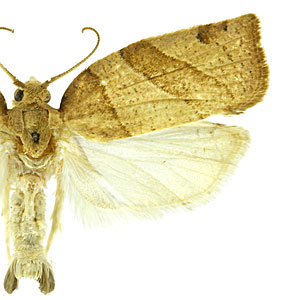Adult Recognition

FWL: 8.0-10.5 mm (male); 9.5-12.0 mm (female)
Adults are light brown with fasciate markings and white to light gray hindwings. Pandemis lamprosana can be separated from other Pandemis listed here by the white to light gray hindwings and the lack of dark scales on the second abdominal sternite in the male.
Six species of Pandemis occur in the Nearctic. Four, P. canadana, P. lamprosana, P. limitata, and P. pyrusana, are native, while two, P. cerasana and P. heparana, have been introduced from the Palearctic. All species treated here have a straw (yellow) to brown forewing with brown to dark-brown markings consisting of a patch on the costa below the apex, a median band that extends from costa to dorsum, and a basal band. The two bands (or fasciae) may be lined with light or dark scales in some individuals, creating the appearance of three lines running vertically across the wing. Males have a distinctive notch at the base of the antennae and modified dark scales on the ventral surface of abdominal segments 2-3 (this character is absent in P. lamprosana and P. heparana). Males lack a forewing costal fold.
Species identification within the group is difficult. Pandemis lamprosana, P. cerasana, and P. heparana, can be identified by wing color and male genitalia. The other three species, P. canadana, P. limitata, and P. pyrusana, exhibit variable wing patterns, share identical genitalia, and cannot be reliably separated where their distributions overlap. The following table lists a combination of wing color and geographic distribution that can be used to identify many Pandemis individuals collected in the U.S.
| Pandemis species | Forewing color | Hindwing color | Sex scales on male 2nd abd. segment | Distribution |
| canadana | medium to dark brown | all gray | present | Maine, Colorado, Wyoming, Southern Canada |
| cerasana | straw to light brown | grayish brown | present | Pacific Northwest, British Columbia; Europe and Asia |
| heparana | medium brown | light to medium grayish brown | absent | Pacific Northwest, British Columbia; Europe and Asia |
| lamprosana | tan to light brown | white to light gray | absent | Northeastern U.S., southern Quebec and Ontario |
| limitata | straw to medium brown | gray and white | present | Eastern U.S. and southern Canada; generally absent in the U.S. west of the Rocky Mtns. |
| pyrusana | straw to medium brown | all white | present | Rocky Mtns. west to California, southern Alberta and British Columbia |
Larval Morphology

Late instar larvae are approximately 20 mm in length and are entirely green and unmarked with moderately large pinacula and long setae. Earlier instars may have a dark lateral mark on each side of the prothoracic shield. A well developed anal comb is present with 6-8 teeth.
MacKay (1962) examined several species of Nearctic Pandemis and could find no species-specific larval characters. Diagnostic characters for the genus include: SD2 on A1-8 on same pinaculum as SD1; L1 and L2 anterior to spiracle on A2-8; SV group on A1,2,7,8,9 usually 3:3:3:2:2; D2s on A8 as far apart as D1s; D1 on A9 on its own pinaculum; anal setae very long; anal comb with 6-8 teeth.
Biology

Pandemis lamprosana completes a single generation per year. Adults are present in late June and July.
Females lay eggs on the upper surface of leaves in large masses. Larvae feed on leaves and have not been observed feeding on fruit. Third instar larvae construct a hibernaculum in a protected site and overwinter until the following spring. Feeding resumes in the spring, and larvae do not complete development until June. Pupation occurs in the final larval feeding site.
Host plantsLarvae have been recorded feeding on a variety of deciduous trees. Reports of larvae feeding on Urticaceae in Illinois are questionable.
| Family | Genus/species | Common name |
| Aceraceae | Acer rubrum L. | red maple |
| Aceraceae | Acer saccharinum L. | silver maple |
| Aceraceae | Acer spicatum Lam. | mountain maple |
| Betulaceae | Betula alleghaniensis Britton | yellow birch |
| Betulaceae | Betula papyrifera Marshall | paper birch |
| Betulaceae | Ostrya virginiana (Mill.) K. Koch | hophornbeam |
| Fabaceae | Gleditsia triacanthos L. | honeylocust |
| Fagaceae | Fagus L. | beech |
| Fagaceae | Quercus L. | oak |
| Fagaceae | Quercus rubra L. | red oak |
| Hamamelidaceae | Hamamelis L. | witchhazel |
| Lauraceae | Sassafras Nees & Eberm. | sassafras |
| Oleaceae | Fraxinus americana L. | white ash |
| Oleaceae | Fraxinus L. | ash |
| Platanaceae | Platanus L. | sycamore |
| Rosaceae | Prunus virginiana L. | chokecherry |
| Salicaceae | Populus tremuloides Michx. | quaking aspen |
| Tiliaceae | Tilia americana L. | American basswood |
| Ulmaceae | Ulmus americana L. | American elm |
| Ulmaceae | Ulmus rubra Muhl. | slippery elm |
Distribution

Pandemis lamprosana is found in the northeastern U.S. and southern Canada (Quebec and Ontario).
References

Chapman, P. J. and S. E. Lienk. 1971. Tortricid fauna of apple in New York (Lepidoptera: Tortricidae); including an account of apple's occurrence in the state, especially as a naturalized plant. Spec. Publ. Geneva, NY: New York State Agricultural Experiment Station. 122 pp.
Dombroskie, J. J. 2011. Aspects of archipine evolution (Lepidoptera: Tortricidae). University of Alberta, Department of Biological Sciences. Ph.D. dissertation. 488 pp.

